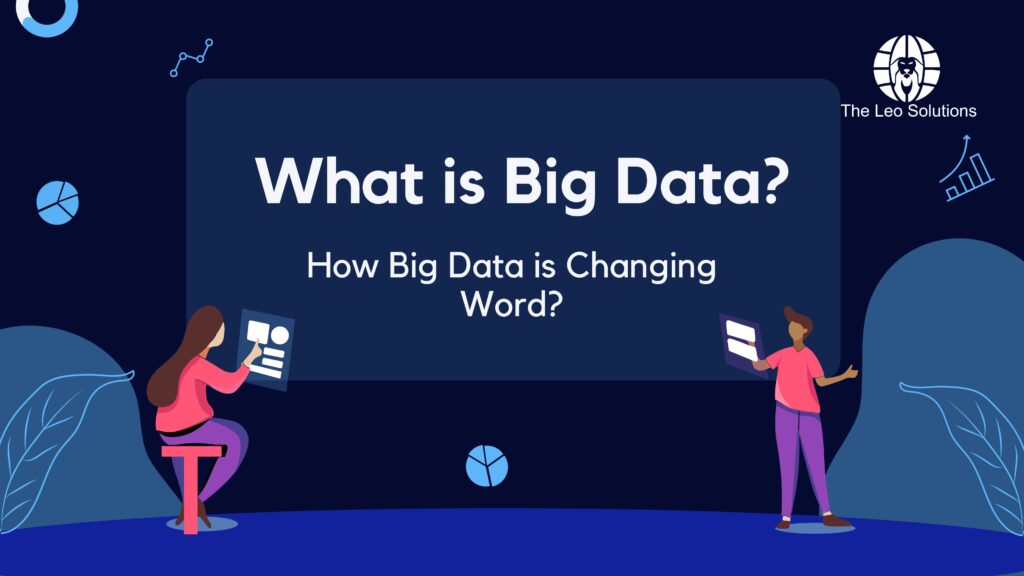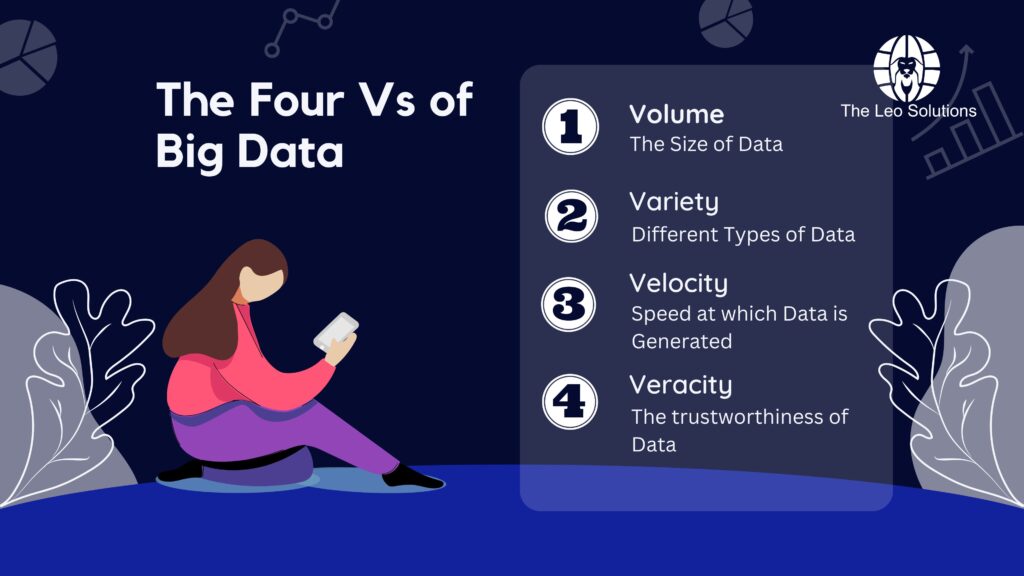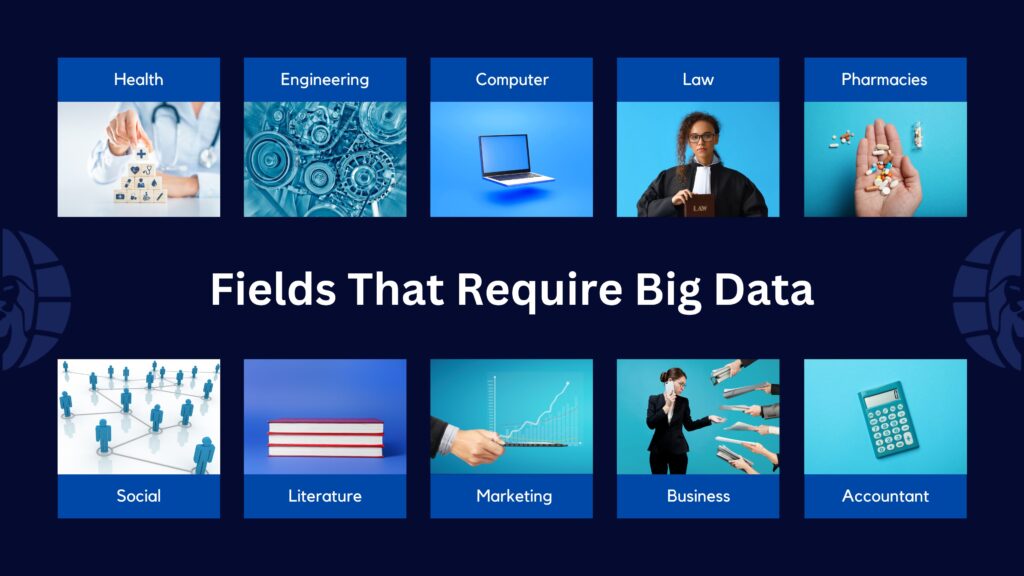
Big Data refers to the large and complex sets of data that are difficult to process and analyze using traditional data processing tools. The term “Big Data” is often used to describe data sets with sizes beyond the ability of typical database software tools to capture, store, manage, and analyze. These data sets are generated from a variety of sources, including social media, sensors, and internet-enabled devices.
The Four Vs
Big Data is characterized by four key attributes known as the “4Vs“: Volume, Variety, Velocity, and Veracity. Volume refers to the sheer size of the data set, which can be measured in terabytes or petabytes. Variety refers to the different types of data that are included in the set, such as structured, semi-structured, and unstructured data. Velocity refers to the speed at which data is generated and processed, and veracity refers to the quality and credibility of the data.

The increasing availability of Big Data has led to a wide range of new applications in various fields. In healthcare, for example, Big Data is used to analyze patient data and improve disease diagnosis and treatment. By analyzing large amounts of medical data, doctors and researchers can identify patterns and trends that may not be immediately obvious. This information can be used to develop new treatments and therapies, and to improve the efficiency of the healthcare system as a whole.

Yes, big data is used in a variety of fields beyond healthcare, including finance, retail, transportation, and manufacturing. In finance, big data can be used to identify fraudulent transactions and detect patterns that indicate financial risk.
In finance, Big Data is used to detect fraudulent transactions and identify potential investment opportunities. Financial institutions can use data mining techniques to analyze large amounts of financial data, such as transaction records, credit reports, and stock market data. By identifying patterns and anomalies, they can quickly detect fraudulent activity and take steps to prevent it. Additionally, by analyzing market data, they can identify potential investment opportunities that might otherwise go unnoticed.
Big data in healthcare refers to the use of large volumes of diverse data from various sources, such as EHRs, clinical trials, genomics, social media, and wearables, to gain valuable insights and improve patient care. By analyzing this data, healthcare organizations can identify patterns and trends in patient health, improve population health management, reduce costs, enhance research and drug discovery, and improve patient outcomes. However, the use of big data in healthcare also poses challenges such as data quality, privacy, and security, and requires proper infrastructure, tools, and expertise to process and analyze effectively.
In marketing, Big Data is used to analyze consumer behavior and target advertising more effectively. By analyzing data from social media, search engines, and e-commerce websites, marketers can gain insights into consumer preferences, shopping habits, and demographics. This information can be used to develop more effective marketing campaigns, and to target advertising to specific groups of consumers.
In transportation, Big Data is used to optimize routes and improve traffic flow. By analyzing data from GPS sensors, traffic cameras, and social media, transportation companies can identify patterns and trends in traffic flow. This information can be used to optimize routes, reduce congestion, and improve the overall efficiency of the transportation system.
Big Data is also changing the way businesses operate, by enabling them to make more informed decisions based on real-time data analysis. This has led to the emergence of new business models, such as the sharing economy and the Internet of Things. Companies like Uber and Airbnb, for example, use Big Data to match supply and demand in real-time, which allows them to operate more efficiently and effectively.
In addition, Big Data is also driving innovation in the field of machine learning and Artificial Intelligence. Machine learning algorithms need large amounts of data to train and improve, and Big Data provides an abundance of data for these models. This has led to the development of new and more advanced AI algorithms, which are being used in a wide range of applications, such as image recognition, natural language processing, and autonomous vehicles.
However, there are also concerns about the ethical and privacy implications of Big Data. As more data is collected and analyzed, there is a risk that personal information may be misused or mishandled. There is also a need for regulations and policies to ensure that the data is used ethically and that individuals’ privacy rights are protected.
In conclusion, Big Data is changing the world by providing new insights and enabling more efficient decision-making in a variety of fields. It is a powerful tool for businesses, researchers and Scientists.
Applications of Big Data
Big Data Applications refer to the various ways in which organizations are using large and complex sets of data to gain insights and make better decisions. Some of the most common applications of Big Data include:
Predictive Analytics: Organizations use Big Data to analyze patterns and trends in large sets of data, in order to make predictions about future events or behaviors. Predictive analytics can be used in a wide range of fields, including healthcare, finance, and marketing.
Fraud Detection: Big Data is used to analyze large sets of financial transaction data in order to identify patterns and anomalies that may indicate fraudulent activity. This can help financial institutions to detect and prevent fraud more effectively.
Supply Chain Management: Big Data can be used to optimize logistics and supply chain processes. By analyzing large sets of data from sensors, GPS, and social media, organizations can identify patterns and trends in traffic flow, inventory levels, and customer demand. This can help them to make more informed decisions about production and distribution.
Customer Relationship Management: Big Data can be used to analyze customer data and gain insights into customer preferences and behavior. This can help organizations to develop more effective marketing campaigns and target advertising to specific groups of customers.
Internet of Things: Big Data is an important technology for the Internet of Things (IoT), which refers to the interconnectedness of everyday objects. By collecting and analyzing data from sensors and other IoT devices, organizations can gain insights into the performance and usage of products, and make data-driven decisions to improve products and services.
Cybersecurity: Big Data is used to analyze large sets of data from various sources such as logs, network traffic, and intrusion detection systems, to identify patterns and anomalies that may indicate security threats.
Natural Language Processing: Big Data is used to train machine learning models for natural language processing, which allows computers to understand and interpret human language. This technology is used in a wide range of applications, such as chatbots and virtual assistants.
Personalization: By using big data, organizations can personalize their products, services, and marketing campaigns to the specific needs and preferences of individual customers.
These are just a few examples of the many ways in which Big Data is being used to drive innovation and improve decision-making across a wide range of industries and applications.
Big Data Analytics
Big Data Analytics refers to the process of examining, cleaning, transforming, and modeling large and complex sets of data, with the goal of discovering useful information, informing conclusions, and supporting decision-making. Big Data Analytics is a multidisciplinary field that combines elements of statistics, computer science, and domain expertise to extract insights from data.
There are several key techniques and technologies used in Big Data Analytics, including:
Data Mining: This is the process of discovering patterns and relationships in large sets of data. Data mining techniques include association rule mining, cluster analysis, and anomaly detection.
Data Warehousing: This is the process of storing and managing large sets of data in a central repository. Data warehousing allows organizations to store and access large amounts of data efficiently and effectively.
Data Visualization: This is the process of representing data in a graphical format, such as charts and graphs. Data visualization tools allow users to quickly identify patterns and trends in large sets of data.
Streaming Analytics: This is the process of analyzing data in real-time as it is generated. Streaming analytics allows organizations to detect and respond to events in real-time, such as financial fraud or equipment failure.
Machine Learning: This is a type of artificial intelligence that allows computers to learn from data and make predictions or decisions without being explicitly programmed. Machine learning algorithms can be used to identify patterns and make predictions in large sets of data.
Cloud Computing: This is the delivery of computing services over the internet. Cloud computing allows organizations to store and process large amounts of data at a low cost and scale up as needed.
Big Data Analytics allows organizations to gain insights from large and complex sets of data that would be difficult or impossible to detect using traditional data analysis methods. This can help organizations to make more informed decisions, improve efficiency, and gain a competitive advantage.
It is important to note that the process of Big Data Analytics is not only about technology but also about people and process. The data scientists, business analysts, and domain experts need to work together to define the problem, collect and clean the data, and interpret the results.
